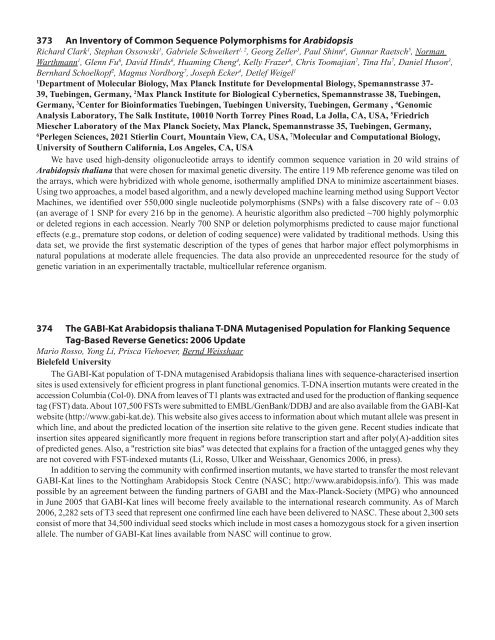75 Integrating Membrane Transport with Male Gametophyte ... - TAIR
75 Integrating Membrane Transport with Male Gametophyte ... - TAIR
75 Integrating Membrane Transport with Male Gametophyte ... - TAIR
Create successful ePaper yourself
Turn your PDF publications into a flip-book with our unique Google optimized e-Paper software.
373 An Inventory of Common Sequence Polymorphisms for Arabidopsis<br />
Richard Clark 1 , Stephan Ossowski 1 , Gabriele Schweikert 1, 2 , Georg Zeller 3 , Paul Shinn 4 , Gunnar Raetsch 5 , Norman<br />
Warthmann 1 , Glenn Fu 6 , David Hinds 6 , Huaming Cheng 4 , Kelly Frazer 6 , Chris Toomajian 7 , Tina Hu 7 , Daniel Huson 3 ,<br />
Bernhard Schoelkopf 2 , Magnus Nordborg 7 , Joseph Ecker 4 , Detlef Weigel 1<br />
1<br />
Department of Molecular Biology, Max Planck Institute for Developmental Biology, Spemannstrasse 37-<br />
39, Tuebingen, Germany, 2 Max Planck Institute for Biological Cybernetics, Spemannstrasse 38, Tuebingen,<br />
Germany, 3 Center for Bioinformatics Tuebingen, Tuebingen University, Tuebingen, Germany , 4 Genomic<br />
Analysis Laboratory, The Salk Institute, 10010 North Torrey Pines Road, La Jolla, CA, USA, 5 Friedrich<br />
Miescher Laboratory of the Max Planck Society, Max Planck, Spemannstrasse 35, Tuebingen, Germany,<br />
6<br />
Perlegen Sciences, 2021 Stierlin Court, Mountain View, CA, USA, 7 Molecular and Computational Biology,<br />
University of Southern California, Los Angeles, CA, USA<br />
We have used high-density oligonucleotide arrays to identify common sequence variation in 20 wild strains of<br />
Arabidopsis thaliana that were chosen for maximal genetic diversity. The entire 119 Mb reference genome was tiled on<br />
the arrays, which were hybridized <strong>with</strong> whole genome, isothermally amplified DNA to minimize ascertainment biases.<br />
Using two approaches, a model based algorithm, and a newly developed machine learning method using Support Vector<br />
Machines, we identified over 550,000 single nucleotide polymorphisms (SNPs) <strong>with</strong> a false discovery rate of ~ 0.03<br />
(an average of 1 SNP for every 216 bp in the genome). A heuristic algorithm also predicted ~700 highly polymorphic<br />
or deleted regions in each accession. Nearly 700 SNP or deletion polymorphisms predicted to cause major functional<br />
effects (e.g., premature stop codons, or deletion of coding sequence) were validated by traditional methods. Using this<br />
data set, we provide the first systematic description of the types of genes that harbor major effect polymorphisms in<br />
natural populations at moderate allele frequencies. The data also provide an unprecedented resource for the study of<br />
genetic variation in an experimentally tractable, multicellular reference organism.<br />
374 The GABI-Kat Arabidopsis thaliana T-DNA Mutagenised Population for Flanking Sequence<br />
Tag-Based Reverse Genetics: 2006 Update<br />
Mario Rosso, Yong Li, Prisca Viehoever, Bernd Weisshaar<br />
Bielefeld University<br />
The GABI-Kat population of T-DNA mutagenised Arabidopsis thaliana lines <strong>with</strong> sequence-characterised insertion<br />
sites is used extensively for efficient progress in plant functional genomics. T-DNA insertion mutants were created in the<br />
accession Columbia (Col-0). DNA from leaves of T1 plants was extracted and used for the production of flanking sequence<br />
tag (FST) data. About 107,500 FSTs were submitted to EMBL/GenBank/DDBJ and are also available from the GABI-Kat<br />
website (http://www.gabi-kat.de). This website also gives access to information about which mutant allele was present in<br />
which line, and about the predicted location of the insertion site relative to the given gene. Recent studies indicate that<br />
insertion sites appeared significantly more frequent in regions before transcription start and after poly(A)-addition sites<br />
of predicted genes. Also, a "restriction site bias" was detected that explains for a fraction of the untagged genes why they<br />
are not covered <strong>with</strong> FST-indexed mutants (Li, Rosso, Ulker and Weisshaar, Genomics 2006, in press).<br />
In addition to serving the community <strong>with</strong> confirmed insertion mutants, we have started to transfer the most relevant<br />
GABI-Kat lines to the Nottingham Arabidopsis Stock Centre (NASC; http://www.arabidopsis.info/). This was made<br />
possible by an agreement between the funding partners of GABI and the Max-Planck-Society (MPG) who announced<br />
in June 2005 that GABI-Kat lines will become freely available to the international research community. As of March<br />
2006, 2,282 sets of T3 seed that represent one confirmed line each have been delivered to NASC. These about 2,300 sets<br />
consist of more that 34,500 individual seed stocks which include in most cases a homozygous stock for a given insertion<br />
allele. The number of GABI-Kat lines available from NASC will continue to grow.





